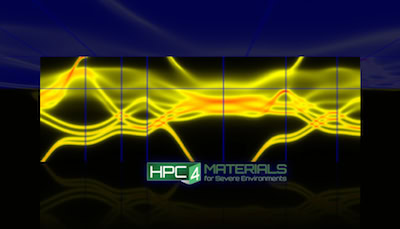
[Image above] Credit: Lawrence Livermore National Laboratory
Researchers and scientists face challenges in the lab every day, as they experiment and explore new ways to improve our lives. But sometimes an advancement in research can be directly proportionate to the amount of funding a particular project receives to support it.
This week the U.S. Department of Energy (DOE) announced a new initiative between its national labs and private industry to spur development of materials used in severe environments. The High Performance Computing for Materials Program (HPC4Mtls) aims to help industry “solve common materials issues, discover new or improved materials and structures, and enhance their products and processes using the labs’ world-class computational resources and capabilities,” according to a DOE press release.
“Severe environments” refer to extreme conditions such as extreme temperatures, pressure, chemicals, radiation, corrosion, fatigue, or stress conditions, and they often require additional resources—such as advanced lab equipment—that companies may not have access to for testing and further research.
HPC4Mtls solves this by connecting businesses with national labs in a collaborative environment to open access to a plethora of advanced equipment and capabilities. The overarching goal of HPC4Mtls is to reduce costs and time spent on research and increase performance of materials in severe environments, according to a news release from the Lawrence Livermore National Laboratory (LLNL).
And for the federal government, it’s all about bringing advanced energy research to market more quickly. “This initiative combines two crucial elements of the administration’s mission at DOE—advances in high-performance computing and the improved transition of energy technologies to market,” Secretary of Energy Rick Perry announced in the DOE’s release earlier this week.
All DOE labs are eligible to participate in the program, but the principal labs include National Energy Technology Laboratory, LLNL, Los Alamos National Laboratory, and Oak Ridge National Laboratory.
“The DOE national labs have cutting-edge capabilities in this topic that are ready to be applied to challenging industry problems,” Jeff Roberts, LLNL’s deputy director for Energy and Climate Security, explains in the LLNL release.
Collaborations with the national labs will offer various capabilities, including:
- Access to five of the world’s fastest computers,
- Higher-fidelity simulations to expand products and processes,
- Prediction of material behavior in specific environments,
- Modeling of missing physical phenomena to enable more realistic simulations,
- Complex model development, and
- Access to subject matter experts in a variety of disciplines.

The DOE National Laboratories host five of the top 10 HPC systems in the world. The photo above shows Vulcan at LLNL, Trinity at LANL, Titan at ORNL, and Peregrine at NREL. Credit: HP4CMtls
“This forward-looking initiative builds on our efforts with other national labs to apply the Department of Energy’s unique leadership computing capabilities to advance forefront science and technology,” LLNL director Bill Goldstein adds.
HPC4Mtls is sponsored by the DOE Offices of Fossil Energy, Nuclear Energy, and Energy Efficiency and Renewable Energy. The program will seek proposals starting in early 2018. Interested companies will be required to provide 20% of the total amount of the project cost.
The DOE plans to hold a workshop on October 12 in Pittsburgh, Pa.,—which also happens to the time and place of MS&T17—to provide more details about the program.
For more information, visit the HPC4Mtls website and check out the FAQ page to get your questions answered.
Did you find this article interesting? Subscribe to the Ceramic Tech Today newsletter to continue to read more articles about the latest news in the ceramic and glass industry! Visit this link to get started.
Author
Faye Oney
CTT Categories
- Basic Science
- Energy
- Manufacturing
- Market Insights
Related Posts
Hype cycles: The uphill climb for hydrogen bikes
June 26, 2025


